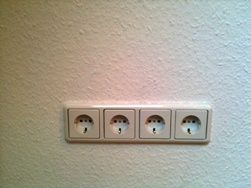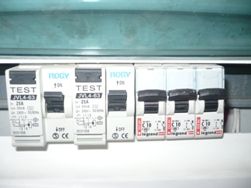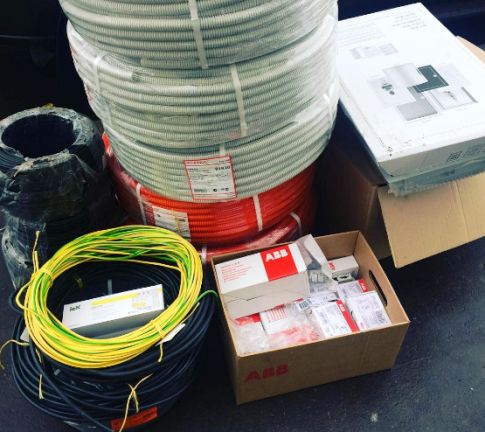Categories: Featured Articles » Electrician at home
Number of views: 32725
Comments on the article: 2
Electrical wiring device in the apartment
 At times, it seems that enough has been said about the rules for installing and operating electrical wiring. But, oddly enough, the question "what is the wiring and how is it arranged?" still many may be confused.
At times, it seems that enough has been said about the rules for installing and operating electrical wiring. But, oddly enough, the question "what is the wiring and how is it arranged?" still many may be confused.
If you believe GOST, then electrical wiring in an apartment is a combination of all conductors, as well as fasteners and fixation devices for these conductors, together with installation products and protection devices.
That is, the input cable, socket conductors and wires of the lighting circuit are electrical wiring. Sockets, switches, most of the lamps are also electrical wiring. We include junction boxes, cable channels, switchboards and automatic machines there.
These are, so to speak, “actors.” And the “plot” is a simple relationship and relationship of these elements.
Begins electrical wiring in the apartment from the input cable. This is a conductor, the minimum cross-section of which, according to the rules, is at least 2.5 square millimeters in copper, connecting the input circuit breaker and the drive-in vertically laid wires. But during installation it is better, after all, to take a certain margin taking into account the current electricity consumption in residential premises and choose a section for entering at least 4 squares. You can clarify this parameter in the technical specifications for connection from the energy sales organization.
It is possible to lay the input cable both hidden and open. Only in very rare cases does the housing operating organization (for example, Housing Office) impose any strict requirements on the condition of the staircase interior, which can be damaged by an additional cable channel and an open cable.
On a journey through wiring, the next item after entering becomes apartment distribution board with the automata contained in it and a counter. This shield recently most often is located inside the apartment for reasons of safety and ease of maintenance.
 The most classic set of circuit breakers is an introductory two-terminal circuit with a rating of 40 amperes, a circuit breaker for a 25-32 ampere plate, several 16-25 amp circuit breakers, and one or two circuit breakers with a rating of 10-16 amperes. All machines have characteristic C. Currently, during installation, more and more attention is paid to the latest recommendations of the PUE: as input and outlet automatic machines, differential ones are used.
The most classic set of circuit breakers is an introductory two-terminal circuit with a rating of 40 amperes, a circuit breaker for a 25-32 ampere plate, several 16-25 amp circuit breakers, and one or two circuit breakers with a rating of 10-16 amperes. All machines have characteristic C. Currently, during installation, more and more attention is paid to the latest recommendations of the PUE: as input and outlet automatic machines, differential ones are used.
In addition to automatic machines and a counter, other devices are often installed in modern apartment shields: RCDs, various relays and small-sized contactors (starters). Zero protective and working tires are also required. The shield itself can be both overhead and built-in execution, and for hidden wiring it’s not necessary to brick up a shield in any niche.
Wiring cables are laid in all directions from the shield. According to current standards, it should be three-wire NYM or VVGNG cables. To connect the plate, a cable with a cross section of 2.5-4 square millimeters in copper is required, for outlets - 2.5 "squares", and for lighting circuits - 1.5 squares. In apartments, wiring cables are most often laid in a strob for finishing. Less commonly used are plastic boxes.
But if the cable for connecting an electric stove extends directly to the installation site of this same stove, where a special power connector is installed, then the cables of the outlet network and the lighting network stretch to the junction boxes. This is done for reasons of saving materials and effort.
In the boxes there is a “distribution of the line", for example, to several outlets or to a switch and fixtures.Depending on the wiring design, the boxes can also be overhead for open wiring and built-in (for hollow and solid walls) for hidden wiring.
Accordingly, sub-sockets or mounting boxes for installing switches and sockets are divided. True, for walls made of non-combustible materials, it is allowed to install sockets and switches without any fittings - directly on the wall.
Wiring products for use as part of the apartment wiring should be selected according to the expected load on them. And, if the generally accepted rating of ten amperes is enough for switching almost any household lighting circuits, then it is better to refrain from using outlets, say, for six amperes. The most versatile sockets are those whose contacts are designed for a current perception of 16 amperes.

With sockets and switches, the position is approximately the same as with apartment switchboards: both can be made for installation as part of a hidden or open electrical wiring. And, just like that, sockets and switches for open wiring can be used as part of hidden wiring.
Modern lighting fixtures for apartment wiring are simply dizzying variety. The methods of their installation and installation are also diverse. Usually, the common thing is only the use in installation of the most popular mounting pair “self-tapping screw-plastic dowel”.
The exception is embedded or so-called "Spotlightsmounted in a niche covered with sheet material. They do not require any special fasteners. Such lamps often need to install an additional step-down voltage transformer, and the cables for them are mounted in the voids of the same installation niche.
Lighting fixtures, sockets and switches are the final destination for a home wiring journey, the device of which is actually a bit more complicated than we described. In particular, we deliberately circumvented the topic of wiring in rooms with increased danger, which the apartment must have a bathroom and kitchen: there are a lot of nuances worthy of a separate article.
We recommend reading: How to choose a quality outlet
See also at e.imadeself.com
:
